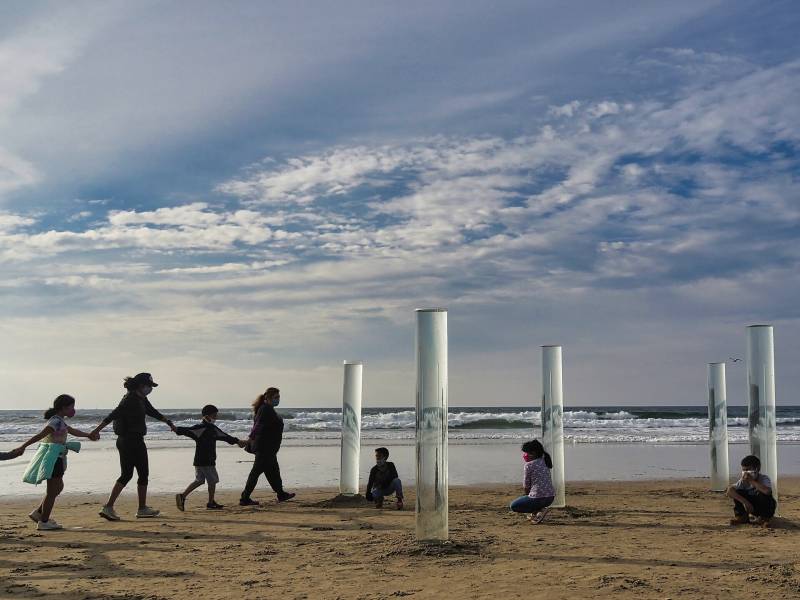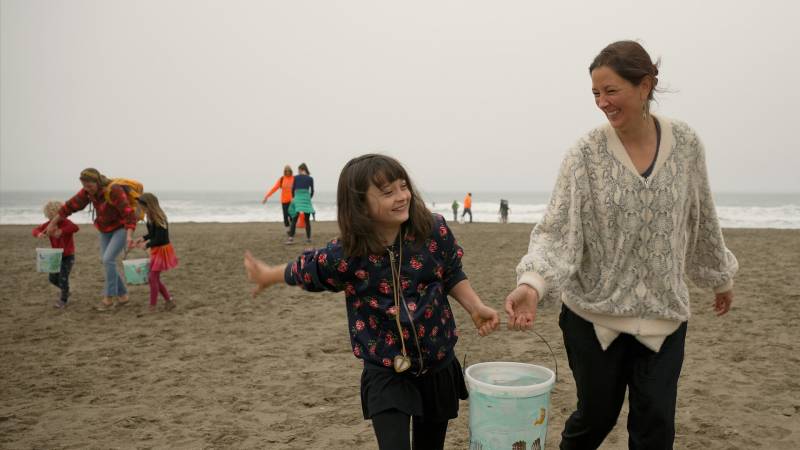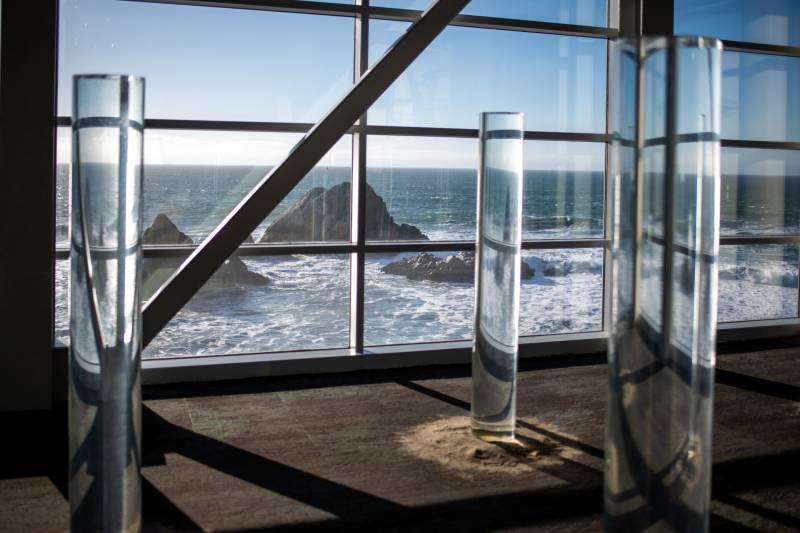Many, many years later, I went to the Art and Environment Conference at the Nevada [Museum of Art], where I was invited to speak about borders in 2017.
One of the panelists was talking about climate change. I remember sitting in the audience, just having my arms crossed and thinking, “Huh, six feet. I’m 5’10.'” (Editor’s note: The latest projections put sea level rise as high as 6.5 feet by 2100.)
As someone who surfs and who’s constantly in the water, I know what that feels like — when you’re pushed down under a wave and you actually can’t get to the surface of the water to breathe. It gave me this moment where I was like, huhhh! [Gasps audibly.]
I was like, this is the time where I actually have to connect the dots and do something directly in response to this specific statistic.
I really began to understand that we have a disassociation from these numbers to our bodies. These numbers sit on a page neatly in line in relation to words, but they don’t sit in relation to a body. So how is it that we can have those numbers come off the page and really become an experience, a somatic experience, a visceral experience?
Where did you start when it came to taking action?
It took me about a year to really get the courage to start working on this and start walking towards it and trying to find a way to embody this idea.
Tell me about the installation you ultimately created, called “On the Horizon.”
I wanted to actually take a step to try and tackle this issue. And when I say tackle, I mean, how can I hold it, quite literally? Not only the idea of sea levels rising, but specifically grasp and hold 6 feet of ocean water?
I worked with a fabricator to create a design that would be able to hold 6 feet of ocean water. It’s a [plexiglass] cylinder that’s 10 inches in diameter and 6 feet tall. It looks and feels as if this body of seawater is emerging from the sand.
Some people address them as pillars, but I see them as “sea bodies” because they’re an extension of the body of water that’s in front of us.
When I’ve done this installation, it’s always at the shoreline — literally where the water ends and the land begins.
 Community volunteers help install ‘On the Horizon’ in November 2021, at Playas de Tijuana, Mexico. (Courtesy Carlos Bravo)
Community volunteers help install ‘On the Horizon’ in November 2021, at Playas de Tijuana, Mexico. (Courtesy Carlos Bravo)
What happens during the installations?
One of the things that became really apparent was that people want to touch it; people want to be a part of it.
Every time that we put the piece up at the beach, people would stop us: “What is this?”
When they realize what it’s about, it’s like someone’s knocking them over. Then the second reaction is always walking towards it to touch the water.
People want to see the relationship of their own body to [the sea bodies].
What do you think that says about the human relationship to climate change?
We’re missing a way in which we can experience climate change more physically.
Climate change is usually experienced in really chaotic, violent, sudden, unpredictable ways. But there are not many moments where you can experience climate change in a physical way that is peaceful and calm.
But if you can sit with it, if you can talk to it, I think you can slowly alter behaviors — we can change how we respond.
 Rachel McIntire with daughter Isla were community volunteers in an ‘On the Horizon’ bucket brigade at San Francisco’s Ocean Beach in October 2021. (Courtesy Colectivo)
Rachel McIntire with daughter Isla were community volunteers in an ‘On the Horizon’ bucket brigade at San Francisco’s Ocean Beach in October 2021. (Courtesy Colectivo)
You talk about the community being part of the installation process. Why is that important?
One of the most beautiful parts of this has been that with the installation, I’ve actually gotten closer to my neighbors.
As soon as we start inserting [the tubes] into the sand and then the buckets come out [to carry ocean water to fill the tubes], people are like, “Can I help?”
I’ve worked with the Sunset Co-Op [Nursery School] as well, with the kindergarten kids.
It’s been really beautiful to see how easy it is to educate people through an experience that’s about them creating the piece. Because ultimately, this piece doesn’t exist without the community, because the community are the ones that are actually pouring life into the piece.
What challenges have you come up against?
There’s the external hustle of finding the funding and figuring out the fabrication.
There’s the internal hustle. I sat with this idea for about a year before I let myself try to tackle it because I’m like, “No, it’s too simple. No, it’s not good enough. No, it’s not going to make a difference.”
I was like, “I’m not a climatologist. I’m not a scientist. Can I do this?”
That was something I had to come to terms with — I had touched issues that are very political, that are very much driven by numbers and by statistics and all these things that might not necessarily be artsy. But why not use art as a way to grapple with these issues, help bring people to it and create an awareness in a different way that sits off the page?
There’s a lot of science and it’s printed everywhere. But no matter how many times it gets printed, sometimes we just need to experience it.
How do you juggle this new work with your life?
Like anything, you just make it a priority.
 ‘On the Horizon’ is installed at the FOR-SITE Foundation’s exhibition ‘Lands End’ in San Francisco’s Cliff House. (Beth LaBerge/KQED)
‘On the Horizon’ is installed at the FOR-SITE Foundation’s exhibition ‘Lands End’ in San Francisco’s Cliff House. (Beth LaBerge/KQED)
What have you gained from this work?
A lot of connectivity to the community, both here along this coastline and around different coastlines. People from Israel have contacted me, people from Sweden. People are really eager to amplify the message of protecting the sea.
A lot of doing these things is starting something and then hoping there’s a ripple effect.
Now I’ve been invited to three other exhibitions about climate change. I never thought of myself as a climate artist.
The director of the Sunset Co-Op has told me all these stories about the kids talking about the piece and how they’ve been relating to the water.
It creates its own constellations that exist beyond you. And that’s the beauty of it.




















